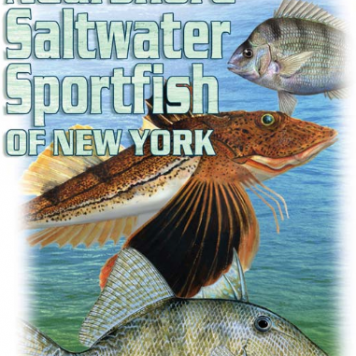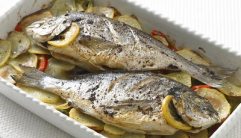Here is a list of fish you can expect to catch in and around New York City, whether from surf spots, or from a fishing boat. This is from a pamphlet published on the DEC website, to which we've added a couple of additional metrics and categories to help make it easier for new fishermen to get familiar with fishing, and for experienced fishermen to discover new species.
Commonly Targeted Recreational Fish:
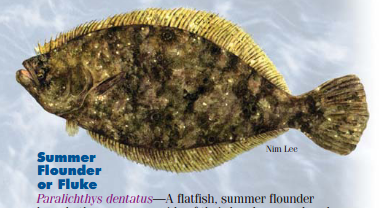 Summer Flounder, A.K.A Fluke
Summer Flounder, A.K.A Fluke
Catch Rating: Intermediate
Paralichthys dentatus—A flatfish, summer flounder have both eyes on one side of their heads, are colored only on the eyed side, and swim on their sides. They have large mouths and sharp canine teeth which they use to eat small fishes, squid, sea worms, shrimp and other crustaceans. Fluke are called left-eyed flatfish because their eyes are on the upper surface of the head when the fish is facing left. Bottom-dwelling predators, they rely on their flattened shape and ability to change color and pattern to surprise prey. Moving inshore in the spring, fluke prefer sand or mud bottoms, but will remain around wharf pilings or other structure. When threatened, they quickly bury themselves in the sand or swim away. Anglers use baited bottom rigs to catch fluke. Average length: 18 inches; average weight: 3 pounds
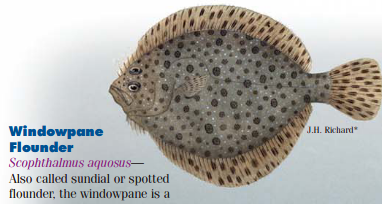 Windowpane Flounder, A.K.A.Sundial
Windowpane Flounder, A.K.A.Sundial
Catch Rating: Intermediate, but are never targeted, occasionally coming up when targeting Fluke/Flounder.
Scophthalmus aquosus— Also called sundial or spotted flounder, the windowpane is a highly compressed, left-sided flatfish (eyes on upper surface of the head when the fish is facing left) with numerous small, irregular, lighter or darker blotches on its head, sides and fins. It is a year-round resident, found over sandy areas in nearshore waters out to deep waters. Like all flounders, both eyes are on one side, there is coloration on the top side only and it swims on its side. In New York, the windowpane is of little importance as a food or game fish, though it is sometimes caught while angling for fluke. Length: up to 19 inches
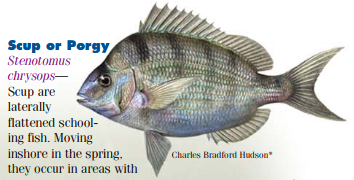 Scup, A.K.A.Porgy
Scup, A.K.A.Porgy
Catch Rating: Easy
Stenotomus chrysops— Scup are laterally flattened schooling fish. Moving inshore in the spring, they occur in areas with smooth or rocky bottoms, and are particularly plentiful around jetties, piers, artificial reefs, offshore ledges and in estuaries. Adults eat bottom invertebrates including small crabs, worms, clams, mussels, jellyfish and shrimp. Large adults will also eat small fishes. Delicious tasting, scup are popular sportfish. They are good fighters and readily bite the bait or small lures used by anglers. Average length: 12 to 14 inches
 Triggerfish
Triggerfish
Catch Rating: Intermediate, but they are never targeted. They travel in Porgy schools, and will occasionally come up when targeting Porgies.
Balistes capriscus—Deep bodied, laterally flattened fish, gray triggerfish inhabit bays, harbors and reefs. Usually solitary or found in small groups, they eat benthic invertebrates such as mollusks and crustaceans. A visitor from the south, triggerfish are generally encountered in the summer and early fall. Anglers love this fish’s meat, preferring it fresh or smoked. This fish can give careless anglers a nasty bite. Length: up to 2 feet
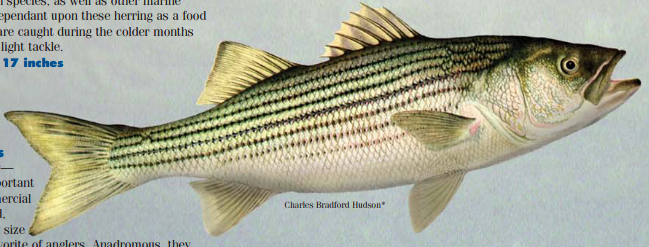 Striped Bass, A.K.A. Stripers
Striped Bass, A.K.A. Stripers
Catch Rating: Difficult/Advanced
Morone saxatilis— Stripers are important sport and commercial fish. Their speed, power and large size make them a favorite of anglers. Anadromous, they move from the sea to freshwater to spawn. They frequently occur around rocky areas near jetties and dropoffs. They are migratory, seasonally entering New York’s tidal portion of the Hudson River and coastal waters around Long Island. Smaller bass generally travel in large schools; larger bass usually move in small pods. Adult stripers are voracious feeders, primarily eating fish and invertebrates, especially crabs and squid. Anglers have the best luck either trolling or drifting with large plugs, spoons, bait or eels, or surf fishing with casting plugs, spoons or jigs. Length: up to 4 1 / 2 feet; weight: up to 70 pounds
 Blue Fish, A.K.A. Blues
Blue Fish, A.K.A. Blues
Catch Rating: Easy
Pomatomus saltatrix—Adult bluefish have a stout body and large mouth that is fully armed with sharp triangular teeth. Aggressive predators, they sometimes continue to capture prey long after their hunger is satisfied. Their feeding behavior is legendary, frequently driving schools of prey fish into shallow areas where it is easier to cripple or catch them. Annually migrating north and south, they usually travel in large schools. Popular sportfish, blues are great fighters. Anglers fish from boat and shore, using a variety of plugs, lures and cut bait. Because of the sharp teeth, use wire leaders. Young bluefish are called ‘snapper.’ Length: up to 31⁄2 feet; weight: up to 25 pounds
 Tautog, A.K.A. Tog/Blackfish
Tautog, A.K.A. Tog/Blackfish
Catch Rating: Intermediate
Tautoga onitus—Tautog or blackfish are dark-colored, stout-bodied fish with thick rubbery lips and a long continuous dorsal fin. In spring, they move from deep into shallow local waters, preferring rocky sheltered areas near reefs, pilings, jetties and wrecks, or around mussel beds. Tautogs have blunt conical teeth used for crushing barnacles, mussels, snails, crabs, shrimps and lobsters. Because tautogs are bottom feeders, anglers use bottom rigs baited with crabs or clams. Max length: 3 feet; max weight: 25 pounds
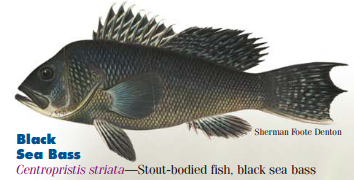 Seabass
Seabass
Catch Rating: Intermediate
Centropristis striata—Stout-bodied fish, black sea bass have large pectoral and pelvic fins, and one long dorsal fin instead of seperate spiny and soft-rayed fins. Small bass occur in bays, while larger ones are found offshore. They are one of the most popular bottom-fish species of the northeast Atlantic Coast. They move inshore in spring, frequenting artificial reefs, wrecks, rocks and pilings. Sea bass eat a variety of bottom-dwelling species, including crabs, fishes, squids and worms. Anglers like their firm, white flesh, using bait such as squid or clams to catch them. Max weight: 10 pounds, but average is only 1 pound
 Weakfish
Weakfish
Catch Rating:
Cynoscion regalis -- Weakfish are long, slender fish with dark spots or wavy lines on their back and sides. They get their name from their tender (or weak) skin around the mouth which tears easily when hooked. Weakfish enter New York’s waters in spring and head south in fall. They are schooling fish and prefer shallow, sandy-bottom areas along beaches, in the mouths of inlets, and in estuaries. Weakfish are predatory and feed mostly on invertebrates and other fish. Anglers fish on the bottom with a variety of baits (squid, worms) and artificial lures (bucktails, diamond jigs) to catch these tasty fish. These fish are most active during times of low light and at night. Length: up to 3 feet; weight: up to 17 pounds
 Mackarel
Mackarel
Catch Rating:
Scomber scombrus— The Atlantic mackerel has a streamlined body and powerful fins that enable it to swim at high speeds. It travels in large schools, with a single school stretching for as long as several miles. Voracious feeders, mackerel cruise near the water’s surface, feeding on smaller fish. Anglers use multi-lure rigs (called mackerel trees) to catch migrating mackerel off Long Island in March or November. Length: up to 2 feet; weight: up to 7 pounds
 Flounder
Flounder
Catch Rating: Intermediate
Pseudopleuronectes americanus—Like fluke, winter flounder are flatfish, characterized by both eyes on one side of their heads, coloration on their top side only, and swimming on their sides. However, they differ from fluke in that winter flounder have small mouths, thick fleshy lips, tiny teeth, and are right-eyed flatfish (both eyes on the upper surface of the head when the fish is facing right). They get their name from the fact that they go into deep water in the summer and reappear in shoal waters during the winter. They prefer sand or muddy bottoms near shellfish beds and grassy areas, eating shrimps, amphipods, crabs, sea urchins and snails. Anglers fish for them on the bottom with mussels or seaworms. Length: up to 25 inches; weight: up to 8 pounds
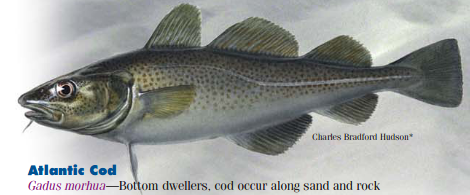 Cod
Cod
Catch Rating: Intermediate
Gadus morhua—Bottom dwellers, cod occur along sand and rock bottoms, and around reefs and shipwrecks from 100 to 1,500 feet down. Once common in New York, they can grow immense, with one fish recorded at nearly 6 feet long and more than 200 pounds. Atlantic cod feed in groups, eating fishes, mollusks, worms, crustaceans and seaweeds. Anglers use fresh shucked clams to catch cod over wrecks or rough bottom in 100-300 feet of water.Average length: 2-3 feet; average weight: 10-20 pounds
Special Trips Recreational Fish:
These fish are found further out, in off-shore waters, and they are targeted by us on special trips:
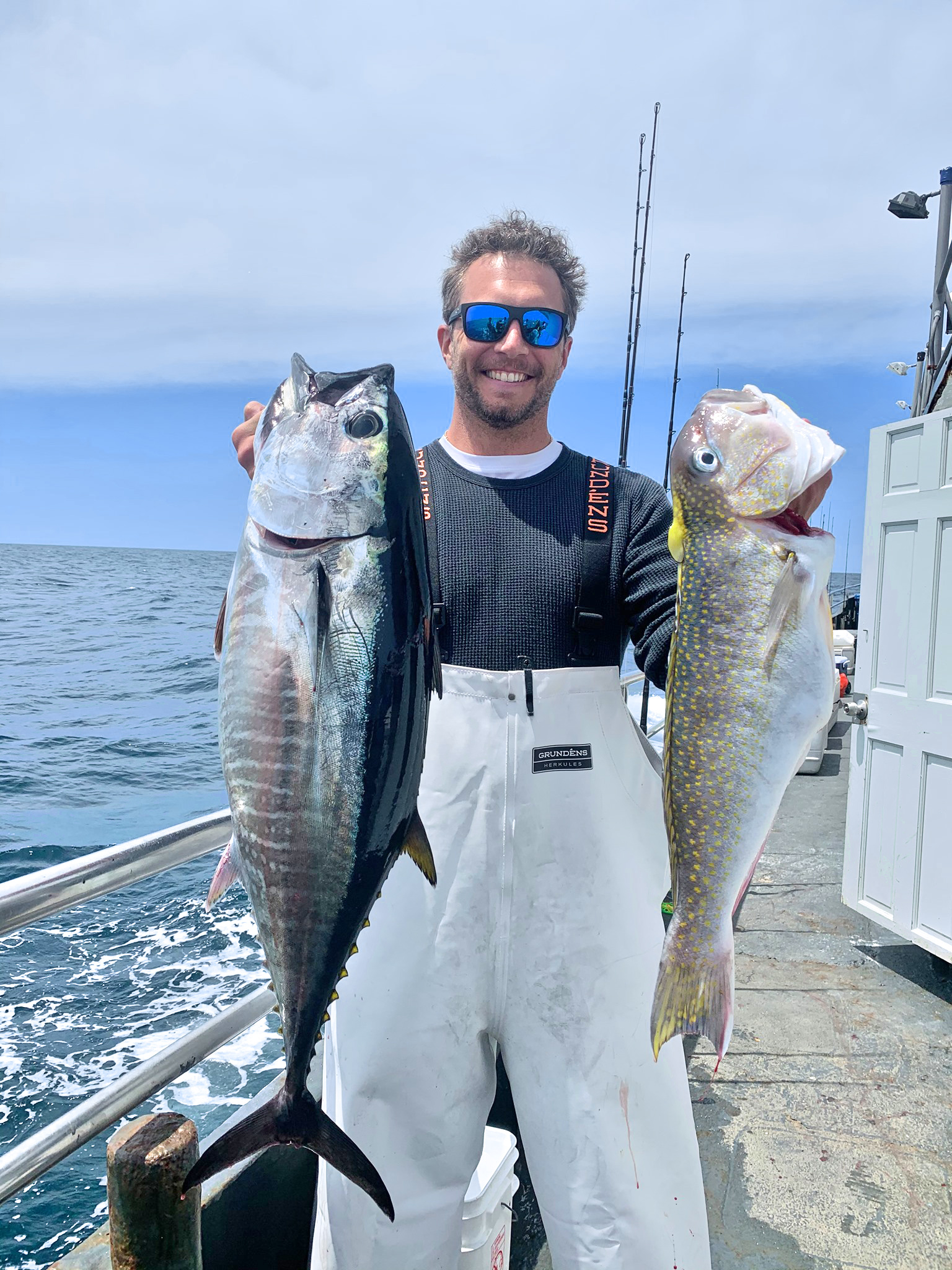 Left: Tuna
Left: Tuna
Catch Rating: Intermediate
Right: Tile Fish
Catch Rating: Easy
"Cool Fish" or "Junk Fish":
These are interesting fish commonly caught while targeting any species listed above, they are usually unwanted by experienced fishermen and tend to be released back into the water, or used for bait.
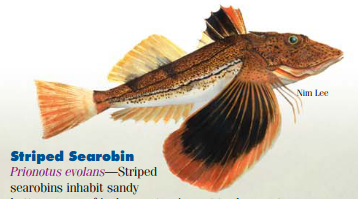 Sea Robin
Sea Robin
Catch Rating: Very Common
Prionotus evolans—Striped searobins inhabit sandy bottom areas of inshore estuaries out to deep water up to 300 feet. They have large bony heads with ridges and spines, and unusual wing-like pectoral fins. Bottom-dwellers, they use modified rays on their pectoral fins to move and stir-up the bottom to find prey such as crustaceans, bivalves, squid and other fish. Searobins get their name from their ability to use their swim bladders to produce sound. They are used for bait and in pet food and fertilizer. Although some anglers enjoy eating searobins, most anglers consider them a nuisance because they compete with more desirable species for the hooked bait. Length: the largest striped searobin ever recorded was taken in Long Island Sound; it was 19.6 inches long and weighed 3.4 pounds
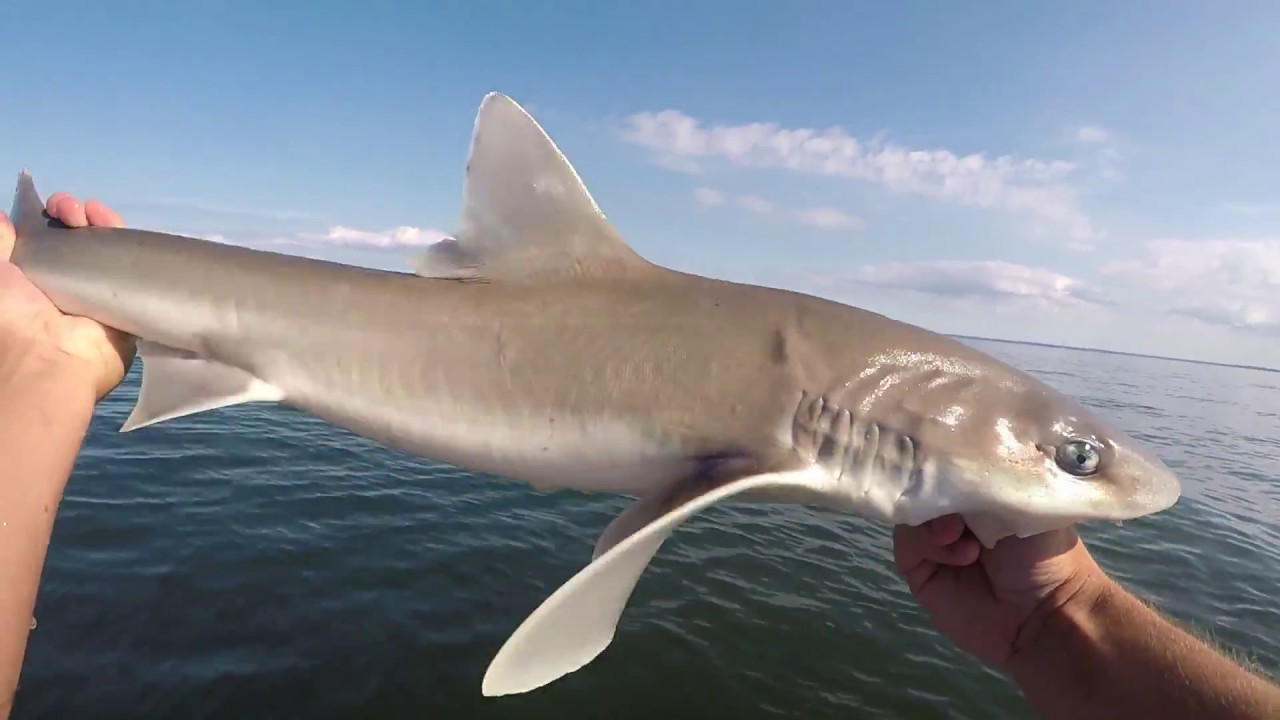 Spiny Dogfish, A.K.A. Sand Shark
Spiny Dogfish, A.K.A. Sand Shark
Catch Rating: Common
These are harmless sharks that live on the sandy bottom and suck up any soft species that can be easily mashed up with thier sand-paper-like "teeth".
 Skate
Skate
Catch Rating: Somewhat Common
These are commonly mis-identified by beginners as Sting-Rays, they are in the "Ray" family, but are harmless as they have no stingers or electrical impulses, as do some larger members of the Rays.
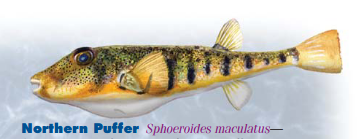 Puffer Fish
Puffer Fish
Catch Rating: Rare
Sphoeroides maculatus— Also called blowfish or swellfish, the puffer gets these names from its ability to inflate its body with air or water. When alarmed or even touched, the puffer uses a special sac that is a ventral extension of the stomach to quickly expand to a very large size, protecting it from enemies. When left alone, it soon deflates. Puffers inhabit bays, estuaries and protected coastal waters, eating primarily shellfish and an occasional finfish. Unlike some of its cousins, the meat of the northern puffer is non-toxic. Length: 10–14 inches
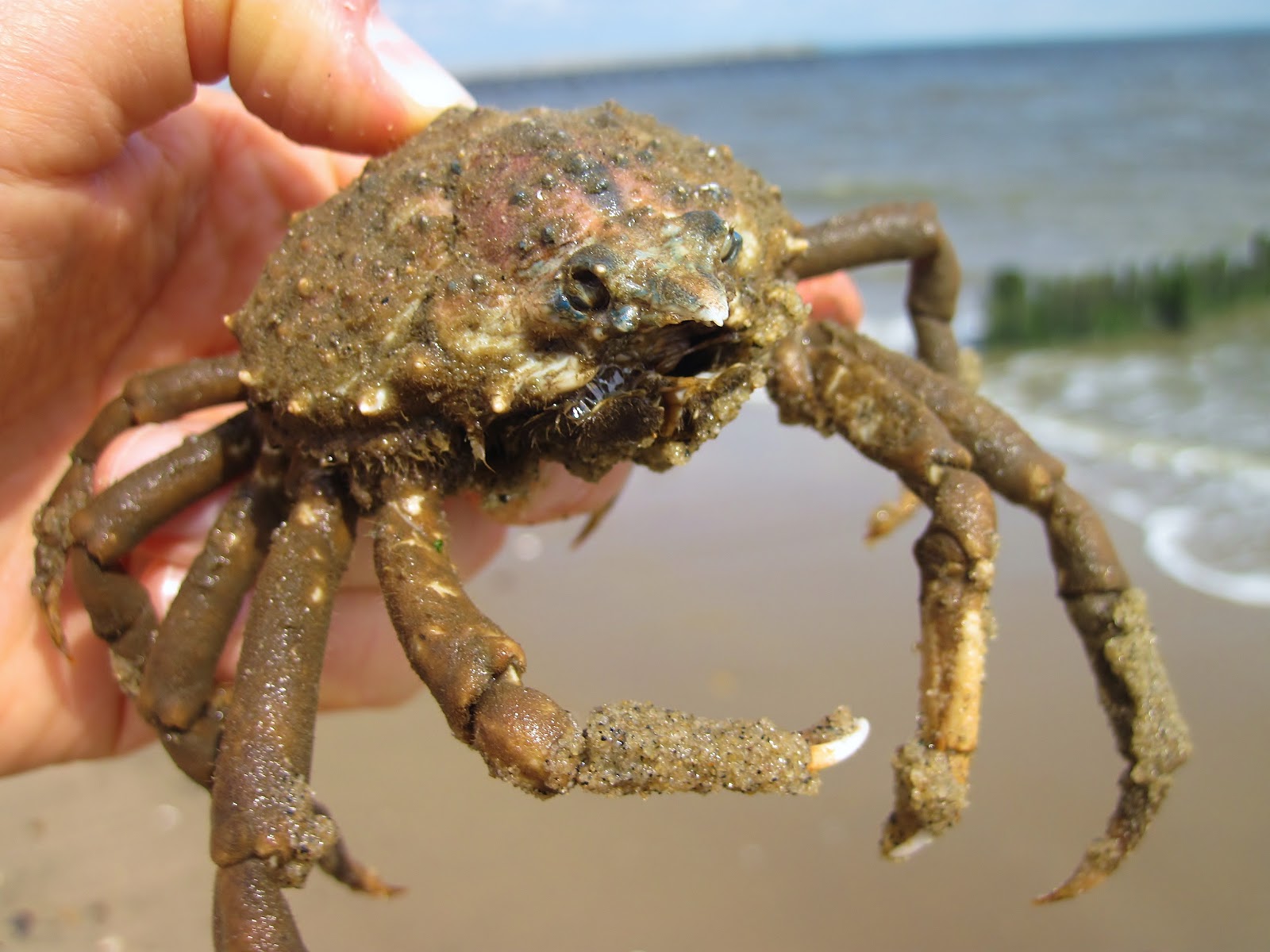 Spider Crab
Spider Crab
Catch Rating: Somewhat Rare
Sometimes a fisherman will feel a weight or tug on thier rod, and will reel it in thinking it's a fish only to find a spider crab hanging on to his hook/line or bait with its' claw. Be careful as they can break skin with a nasty pinch, best to call a mate over if you're uncomfortable handling it. Many time just gently shaking or bouncing the rod around in the air will cause them to let go and fall back in the water.
Best Regards, Capt. Dave Fishing

